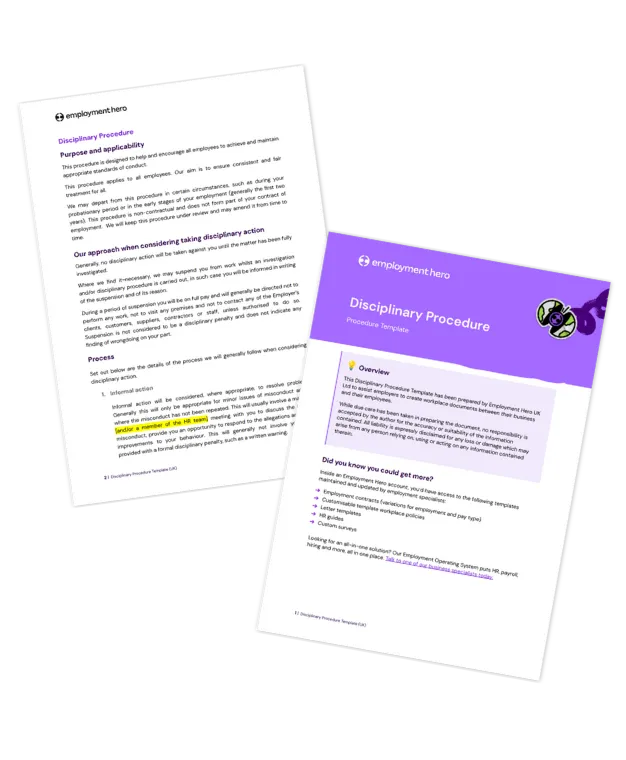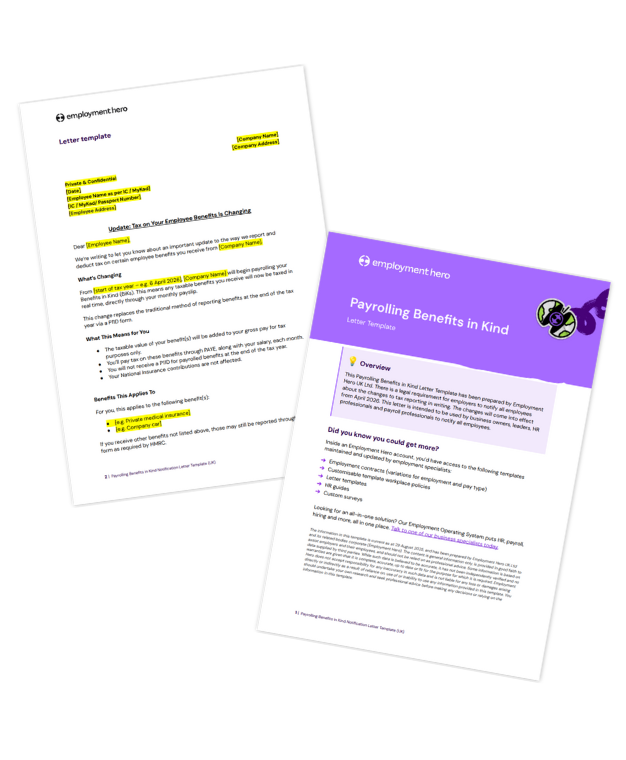Creating disciplinary procedures in the workplace
Published
Creating disciplinary procedures in the workplace
Disciplinary procedures are a structured approach to addressing employee misconduct or underperformance in a fair and consistent manner. They play a crucial role in maintaining workplace harmony, ensuring legal compliance and promoting a culture of accountability.
For UK employers, having robust disciplinary procedures isn’t just best practice; it’s often a legal necessity. This guide explores how to create and implement effective disciplinary procedures, helping you to safeguard your organisation and support your workforce. This free downloadable template will help you to:
- Create a consistent and fair approach to disciplinary procedures
- Document your disciplinary procedures
- Outline clear expectations for both employees and your organisation at each stage
- Outline clear potential outcomes for disciplinary procedures

Why disciplinary procedures are essential in the workplace
An effective disciplinary process is more than just a way to address problems. It’s a fundamental component of fostering trust, maintaining fairness and protecting your organisation.
Legal importance
- Avoiding claims of unfair dismissal: Under UK employment law, employees dismissed without a fair process can bring claims against their employer. A clear disciplinary procedure ensures compliance with the ACAS Code of Practice, helping to mitigate these risks.
- Protecting employers from disputes: Properly documented and applied disciplinary actions provide legal protection, reducing the chance of liability.
- Clarity on rights and responsibilities: A documented procedure explains what is expected of both employers and employees, reducing ambiguity.
Operational benefits
- Encouraging consistent application: A fair process ensures decisions are not arbitrary but based on clearly defined standards. This consistency helps in managing risks and employee expectations effectively.
- Promoting accountability: A structured process creates clear consequences, encouraging employees to meet their performance and conduct obligations.
Cultural impact
- Building a positive workplace culture: By showing that rules are enforced fairly, disciplinary procedures reinforce integrity and mutual respect.
- Supporting employee improvement: Addressing issues constructively gives staff the chance to learn and grow, fostering stronger engagement and performance.
Informal vs formal disciplinary action
Handling discipline isn’t a one-size-fits-all scenario. Understanding when to use informal or formal approaches is essential for balance. Example policy details for these different approaches are included in the template.
Informal actions
The purpose of this approach is to address minor issues early, preventing escalation. Examples of its use include a one-off issue such as lateness or behaviour that doesn’t yet warrant a formal warning. Methods involve verbal discussions to define problems and outline expectations, along with notes for internal records to track patterns, which are not binding. This method is effective for fostering improvement without formal repercussions.
Formal actions
Formal disciplinary action is taken to systematically address more serious or recurring issues. Escalation is warranted for repeat offences, a failure to improve after informal discussions or issues involving misconduct or behavior that significantly impacts the workplace. The process requires documented steps and adherence to legal guidelines.
Using informal routes first where appropriate encourages early intervention, maintaining a positive employee-employer relationship.
Step-by-step disciplinary procedure
When formal action is necessary, a fair and transparent process ensures consistency and legal compliance.
1. Investigation and evidence gathering
- Key actions:
- Conduct a fact-finding process to gather details about the issue.
- Speak to witnesses or review relevant documentation.
- Ensure the investigation is impartial.
- Outcome: Decide whether formal action is warranted based on evidence.
2. Invitation to a disciplinary hearing
- Written notification:
- Clearly outline the allegations.
- Include evidence to be discussed.
- Provide reasonable notice of the time and date.
- Right to be accompanied: Inform the employee of their right to bring a companion (e.g., a colleague or trade union representative).
3. The disciplinary hearing
- Procedure:
- Present the allegations and evidence.
- Allow the employee to respond fully.
- Hear witnesses if applicable.
- Role of the chair: Ensure the process remains fair and focused on facts.
4. Communicating outcomes and next steps
- Outcome letter:
- Detail the decision made (e.g., warning, dismissal).
- Provide reasons and explain next steps.
- Timelines: Send this communication promptly, ideally within five working days.
5. The appeal process
- Rights and communication:
- Employees should know how to appeal against a decision.
- Appeals must be heard impartially and in a timely manner, ideally by someone not involved in the original process.
Handling different types of disciplinary issues
Different situations require tailored approaches to ensure appropriate outcomes.
Misconduct vs gross misconduct
Misconduct typically refers to less severe issues—such as lateness or unprofessional behaviour, which disrupt workplace standards but do not fundamentally breach trust. These situations are often managed with verbal or written warnings and may require additional monitoring to ensure improvement. In contrast, gross misconduct involves serious breaches like theft, violence or other actions that can irreparably damage the employer-employee relationship. Gross misconduct is treated with the utmost seriousness and, following a thorough investigation, may lead to immediate dismissal in line with company procedure.
Underperformance and capability concerns
When dealing with underperformance or capability concerns, the focus should be on providing structured improvement plans. This involves setting clear targets and timescales for the employee to achieve the required standards. Employers should also ensure that the necessary training and support are available to help the individual address any skill or performance gaps. If the employee does not make the required improvements within the agreed timeframe, the matter should be escalated in accordance with the organisation’s disciplinary procedures.
Repeat minor offences
Repeated minor offences can erode team morale and impact overall productivity. It is essential to keep detailed records of all previous incidents and actions taken. If an employee continues to commit minor offences despite earlier interventions, managers should escalate disciplinary measures appropriately. This may involve moving from verbal to written warnings to demonstrate the seriousness of the issue and encourage meaningful change.
An effective policy should promote transparency, fairness and respect. Follow these principles:
- Transparency and documentation: Ensure expectations and rules are well-communicated. Maintain comprehensive, accessible records of all disciplinary actions.
- Consistency across roles: Apply procedures uniformly to avoid claims of discrimination or favouritism. Implement clear training for managers involved in applying the policy.
- Respect for employee rights: Allow employees to present their case. Guarantee the right to a trade union representative or work colleague at formal hearings.
- Use of Neutral Parties: Engage impartial decision-makers, especially during investigations and appeals.
How Employment Hero can help
Employment Hero simplifies complex HR processes, giving Small-to-Medium Enterprises (SMEs) the tools they need to handle disciplinary matters confidently. Here’s how we can help:
- HR templates and resources: Access ready-to-use policies, procedures and letters tailored to UK laws.
- Compliance alerts: Stay up to date with real-time updates on legislation changes.
- Employee management tools: Monitor performance and record incidents efficiently.
- Expert support: Connect with HR specialists for advice on compliance issues.
By centralising these tools in one platform, Employment Hero can help you to save time, reduce risk and manage compliance. If you’re looking for more than one policy, talk to our business specialists and book a demo of our platform.
Get started today with the template
Having proper disciplinary procedures in place is essential for any UK employer. By addressing issues fairly and transparently, you not only protect your business but also foster a culture of trust and accountability.
The information in this article is current as at 14 August 2025, and has been prepared by Employment Hero UK Ltd and its related bodies corporate (Employment Hero). The views expressed in this article are general information only, are provided in good faith to assist employers and their employees, and should not be relied on as professional advice. Some information is based on data supplied by third parties. While such data is believed to be accurate, it has not been independently verified and no warranties are given that it is complete, accurate, up to date or fit for the purpose for which it is required. Employment Hero does not accept responsibility for any inaccuracy in such data and is not liable for any loss or damages arising directly or indirectly as a result of reliance on, use of or inability to use any information provided in this article. You should undertake your own research and seek professional advice before making any decisions or relying on the information in this article.
Frequently asked questions about disciplinary procedures
The disciplinary process typically starts with an investigation to gather all relevant facts. For minor infractions, an informal approach might be taken, such as a casual discussion or a verbal warning. However, for more serious issues or repeated minor offenses, formal disciplinary procedures will be initiated. These formal procedures usually involve a series of steps, including written warnings, disciplinary hearings and potentially dismissal, depending on the severity and persistence of the misconduct. The aim throughout the process is to address the issue fairly and consistently, ensuring that employees are aware of the expected standards of conduct and the consequences of failing to meet them.
Fairness in disciplinary procedures is paramount to maintaining a just and respectful workplace. It involves several key elements: following clearly outlined steps, providing employees with a genuine opportunity to respond to allegations, presenting clear evidence to support any claims, and offering transparent and understandable reasoning behind all decisions made. This structured approach helps ensure that disciplinary actions are perceived as equitable and are legally defensible, fostering trust and a positive working environment.
While timelines for disciplinary procedures can vary significantly depending on the complexity of the case, it is crucial to proceed with reasonable speed. Unnecessary delays in the process can lead to claims of unfair treatment by the employee, potentially escalating the situation and introducing legal risks for the employer. Employers should aim to complete each stage of the disciplinary process in a timely manner, providing clear communication and adhering to any internal policies or statutory guidelines regarding timescales.
Gross misconduct typically involves severe breaches of conduct that fundamentally undermine the employment relationship. While gross misconduct can justify dismissal without formal notice (summary dismissal) when proven, it is a very high threshold to meet and employers should still follow a fair disciplinary process. However, even in such cases, a preliminary investigation is crucial. This investigation aims to swiftly confirm the factual basis of the alleged misconduct and ensure that the decision to terminate is based on verified information, not just suspicion or assumption. Employers should also hold a disciplinary meeting and provide the employee with the opportunity to respond ahead of making any decisions. These steps are to maintain fairness and mitigate potential legal challenges.
To download the template, we just need a few quick details.
Related Resources
-
 Read more: Payrolling Benefits in Kind (BIKs): Employer Obligations (+ Notification Letter Template)
Read more: Payrolling Benefits in Kind (BIKs): Employer Obligations (+ Notification Letter Template)Payrolling Benefits in Kind (BIKs): Employer Obligations (+ Notification Letter Template)
Stay up-to-date with upcoming rules on benefits in kind (BIKs) payrolling. Learn what’s mandatory from 2026, current obligations & download…
-
 Read more: A Business Owners Guide to Adopting AI
Read more: A Business Owners Guide to Adopting AIA Business Owners Guide to Adopting AI
Discover how to successfully navigate AI adoption in your business. This guide covers key steps, benefits, risks and real-world tips…
-
 Read more: Work-Related Social Events Policy Template
Read more: Work-Related Social Events Policy TemplateWork-Related Social Events Policy Template
Ensure your staff social events run smoothly with our workplace social events policy template. Customisable and easy to use.



















